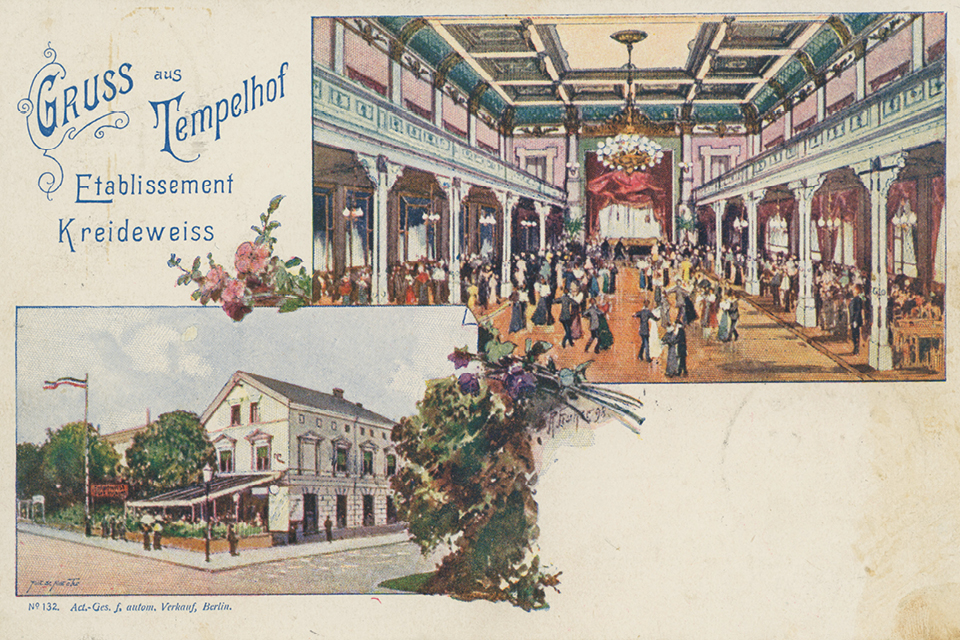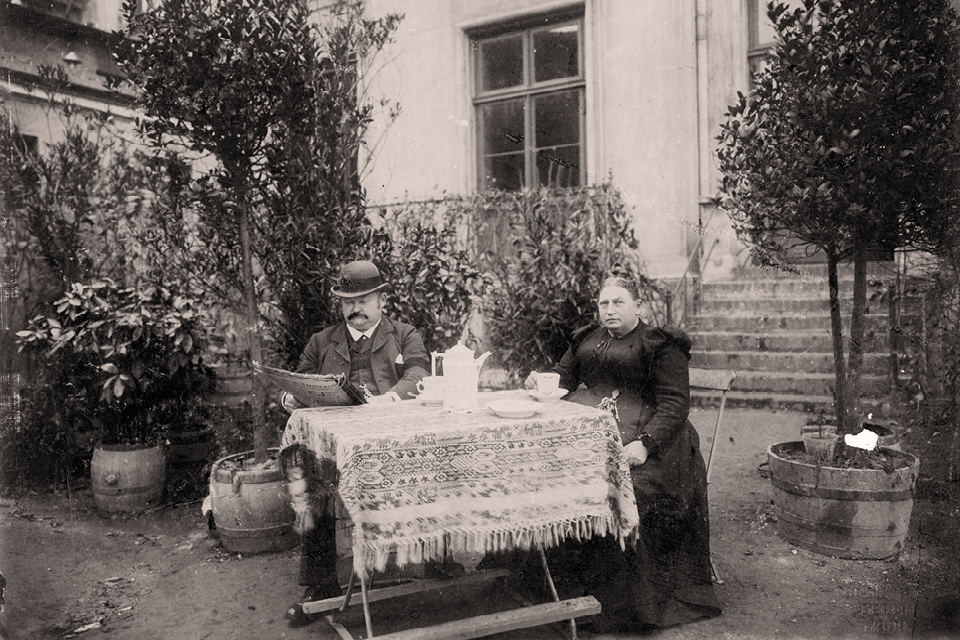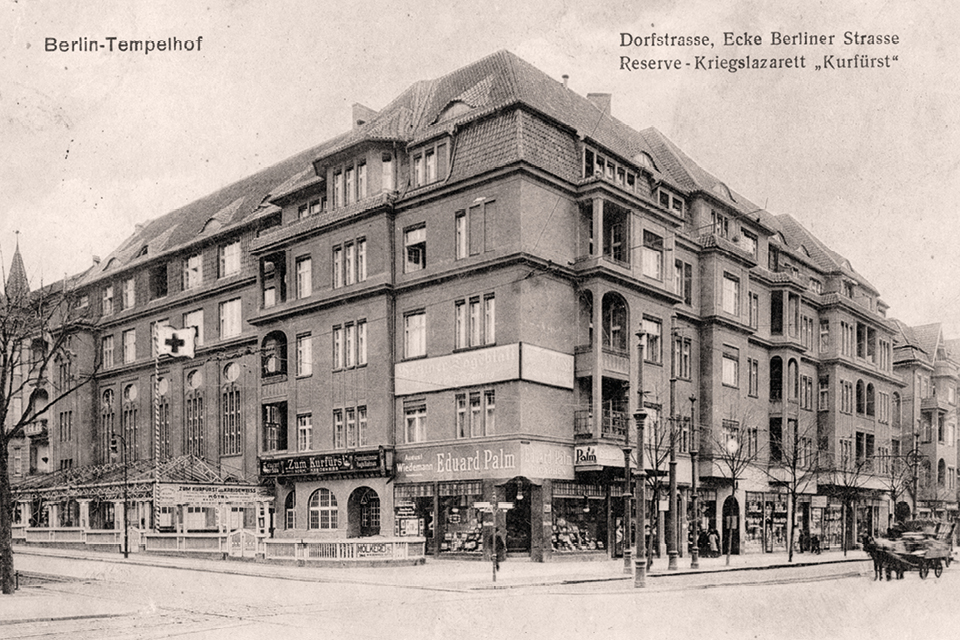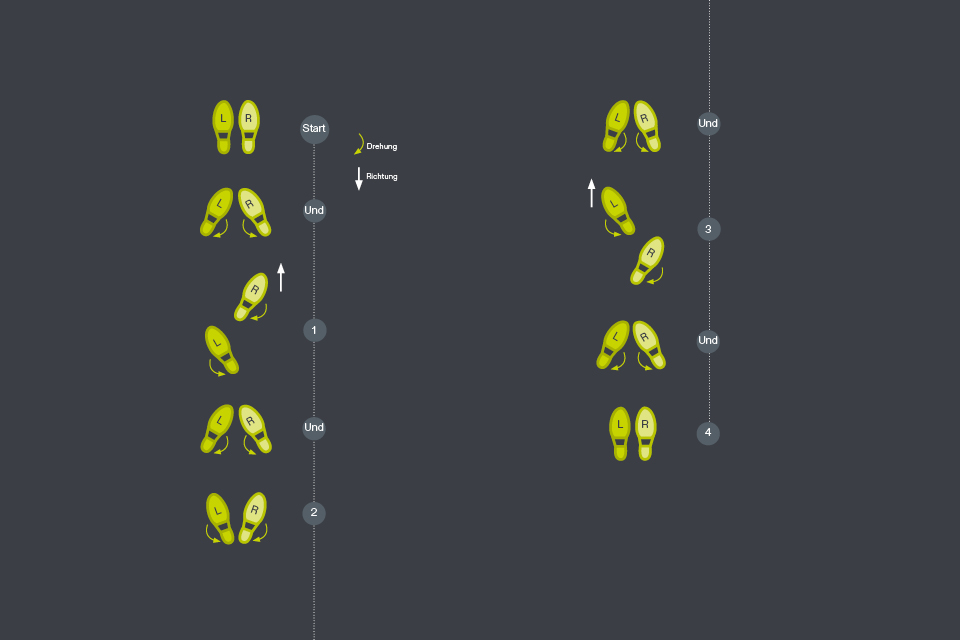Kreideweiß
Where did dances take place in Tempelhof? The village of Tempelhof was a popular destination for people from the city. They came to have fun in the numerous pubs and dance halls. As a souvenir, they sent a postcard to Mitte!
“A weekend in the mid-1920s…”
Amusement in Tempelhof: Else Edelstahl and Arne Krasting take us back in time to the recreation and entertainment opportunities in Tempelhof a century ago. Dance halls, cinematographs, 9-pin alleys and swimming pools attracted fun-loving Berliners.
Audio transcription
Here you will find the podcasts audio transcription >>
“Hi everybody, we’re Else Edelstahl from Boheme Sauvage and Arne Karsting from Zeitreisen. We’ve been making a podcast about the 1920s called Goldstaub, der Zwanziger-Jahre. Today we’re taking you on a journey back in time.”
“We’ve landed in the middle of the 1920s. It’s a weekend, and we want to go find some wild nightlife. The only question is – where’ll we end up this time?”
“Friedrichstraße? It has the Admiralspalast, Wintergarten and Mokka Efti.”
“How about the new west around Tauentzienstraße and Ku’damm. There’s the Delphi dance palace and the Kakadu bar.”
“Honestly what I’d really like is something new. To escape the stress of the big city. Something not quite as fast-paced.”
“Look at this, Else. It’s an ad for a restaurant and café called Zum Kurfürst, or the former Kreideweiß.”
“Sounds familiar – it’s in Tempelhof, right?”
“The swankiest place in the south ‒ concerts every day – cabaret on Friday evenings – and princely cuisine.”
“That sounds superb. How can we get there?”
“On the underground, of course!”
“It doesn’t go all the way. We’d still have a long walk.”
“Maybe the electric rail? There should be a direct line from Kreuzberg.”
“Shall we make ourselves really chic – and show up in our latest evening attire?”
“Wear your turquoise dress with the beaded fringe, and do your hair up in those beautiful curls.”
“Oh yes! And really dark eyeliner and bright red lipstick. And you should wear your smart dinner suit and dapper tie, with plenty of pomade in your hair. But first you might want to shave.”
“Your wish is my command!”
“Ah, Else, couldn’t you put on the latest perfume from Paris, what was it called, Chanel Number 5?”
“Just the thing! And I’m so excited about the dances, what do you think they’ll have?”
“Well, probably foxtrot, certainly waltzes, tango surely too. If we’re lucky they might play some wild jazz – do you think the new dances from America have reached Tempelhof?”
“It’s quite possible – then we could dance the charleston.”
“Let’s get moving – the electric rail leaves Hallesches Tor in an hour.”
“What do we know about the establishment we’ve chosen?”
“The Kurfürst opened in 1912. What’s interesting is the reference to the Kreideweiß. Even this ad, which is from 1924, still says ‘formerly the Kreideweiß’. We should find out what exactly the Kreideweiß was.”
“It was a very popular establishment. Or let’s say a destination outside the city. It had a pronounced village feel, but kept getting bigger and became quite well known – with a dance hall and entertainment programme.”
“It looked essentially how you’d imagine buildings of that period. Dance halls were popping up on every corner.”
“This location – which today is at the crossroads of Alt-Tempelhof and Tempelhofer Damm – was actually a social hot spot for quite a while. But then in the early 20th century the old Kreideweiß was torn down and replaced with something completely new. A big Gründerzeit building with lavish entertainment offerings.”
“The Zum Kurfürst entertainment centre had a big ballroom, a restaurant, two bowling alleys in the basement, a beer cellar and a bathing facility with various steam baths and massage rooms.”
“Something for every taste. And that’s not the end of the story. After the war there was a discotheque there.”
“Right, the famous Cartoon in the 1960s and 70s. And today the front part of the building houses the Insomnia, a decadent nightclub.”
“The Insomnia actually evokes what they were celebrating in the 20s, namely sexual liberation, hedonism and tolerance.”
“Have you been there?” – “More than once!”
“Tempelhof was also home to the Ullstein publishing house and the UFA film studios in the 1920s. Where else would the journalists and film crowd have gone in the evenings in Tempelhof otherwise?”
“Well, the ‘dream factory’ film workers could watch their own productions right at the Tivoli. It was an artsy cinema with up to 700 seats. It also had food and drink of course, and two very popular bowling alleys in the cellar.”
“Or they went to the Tuskulum, which was across from the Kreideweiß and then later from the Kurfürst. It too had been a village watering hole, which attracted ever more people and also began hosting wild parties.”
“So – then as now, Tempelhof is the place to be!”
Popular country resort






Let’s go to beautiful Tempelhof!
Around 1825 city dwellers began making excursions to the small village of Tempelhof. Beer gardens and pubs were opened. Other attractions were offered too. Farmhouses, for example, allowed visitors to brew their own coffee or drink fresh milk. Tempelhof was less regulated than Berlin around 1800. Smoking was officially allowed at Tuesday music events at the Schemel family’s village pub. At that time it was still illegal to smoke on the streets of Berlin. In summer, visitors from the city centre outnumbered residents of the village. People who visited the countryside outside Berlin sent postcards from local pubs back home to friends. One famous pub was the Kreideweiß (literally “chalk white”). Others included the Dittner on the north side of the green, the Knoll on the corner of Reinhardtstraße, and the Alte Dorfaue. In 1901 the son of Wilhelm Lehne took over the Helwig pub directly across from the Kreideweiß establishment. Wilhelm Lehne, a notable Tempelhof figure and frequent guest at his son’s pub, acquired the nickname “Father Lehne” – with reference to Auguste, the famous female owner of the Kreideweiß, who was known as “Mother Kreideweiß”.
The Kreideweiß dynasty
The Kreideweiß family leased a pub in 1828 at the traditional site of the village tavern right at the green. A medieval tavern had opened at Dorfstraße 13 in 1375. It was both an eatery and a farmstead. The tavern here had to pay unusual forms of rent over the years. In 1446 rent was 6 groats and a pound of pepper, which was a considerable sum for the time. The tavern burned down in 1748 and again in 1827. The Kreideweiß family then bought the property in 1832 and built what would become their famous pub. The Kreideweiß enjoyed unparalleled popularity for years. It even welcomed Emperor Wilhelm II and his retinue. Many stories are told about its owner, Auguste,
who was known as “Mother Kreideweiß”. Her culinary skills and force of will are legendary. When a waiter once stole a piece of roast meat and hid it in his jacket pocket, she is said to have thrown sauce from the roast at him as he fled.
“Lovely times at the Kreideweiß”
Around 1900 the Kreideweiß became an “establishment”. Every Wednesday it held gala events. It had a 9-pin alley, a large dance hall, and an amusement park. Many songs were written around the turn of the century about the attractions at the outskirts of the city. One of these songs is by Eugen Philippi, who also wrote the popular Rixdorfer Polka. His lyrics for Mittwochs mache ick mir tof are roughly: “Wednesdays dressed from head to toe, off to Tempelhof I go, Whether the day brings sun or ice, it is lovely at Kreidweiß. Dancing is invariably fine, and superb cream is always mine.” The numerous pubs were not the only attractions. A horse-racing course in what is now Mariendorf drew guests from other countries as well. When Tempelhof farmers sold fields to the Prussian military, this too brought prominent visitors to the village. They included Emperor Wilhelm I, Field Marshall General Helmuth von Moltke and Chancellor Otto von Bismarck.

